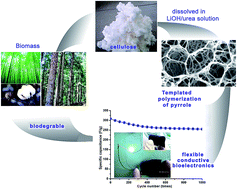Surface modification of cellulose scaffold with polypyrrole for the fabrication of flexible supercapacitor electrode with enhanced capacitance
Abstract
Surface modification of a cellulose scaffold for the preparation of a flexible conductive composite has been carried out using a template-polymerization method. The effects of the concentration of the pyrrole and the reaction time on the structure and properties of the composites have been investigated. The as-prepared polypyrrole/cellulose composites integrated the merits of cellulose with the conductive polypyrrole (Ppy), the structurally defined Ppy/cellulose composites exhibited electrical conductivity as high as 0.59 S cm−1 with a Ppy content of only about 28.89 wt%. Furthermore, it was foldable and could be used as flexible electrode for a supercapacitor. The specific capacitance of CPy-005 was about 392–308 F g−1 at current densities ranging from 0.1 to 0.4 A g−1, and kept a high stability during the charge–discharge cycle; the capacity was decreased by only 18% after 1000 cycles at a current density of 0.4 A g−1. The unique porous bulk structure and rough surface properties enabled the construction of cellulose based flexible supercapacitors with reasonably good performance and a low price, which would provide a candidate for future “green” and “use-once-and-throw-away” electronics.


 Please wait while we load your content...
Please wait while we load your content...